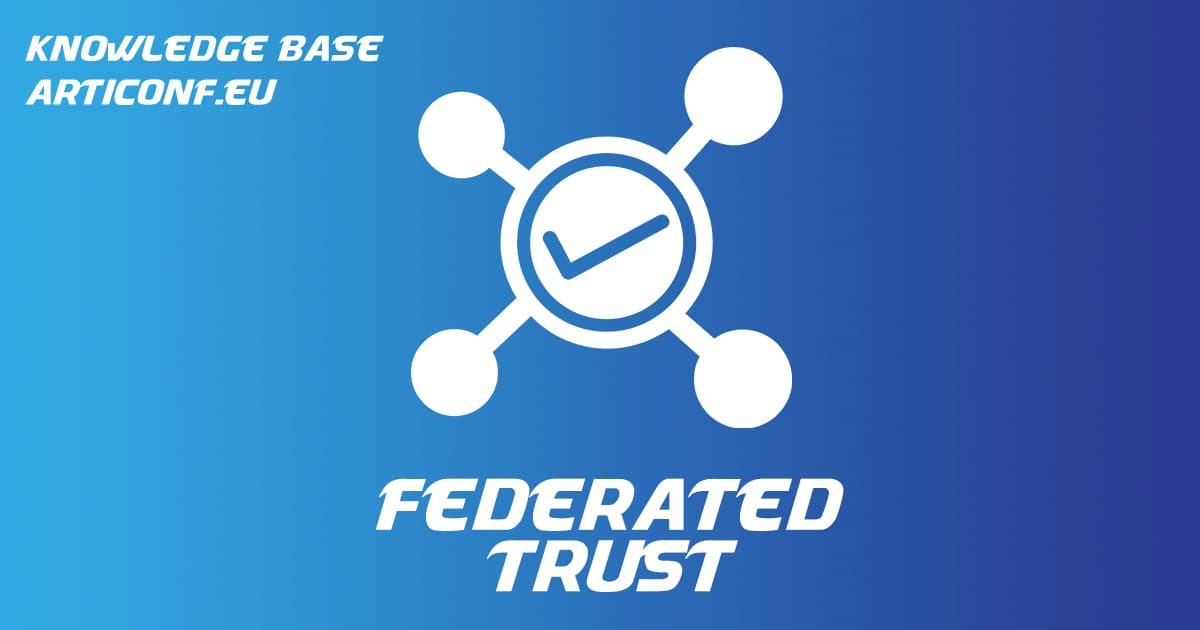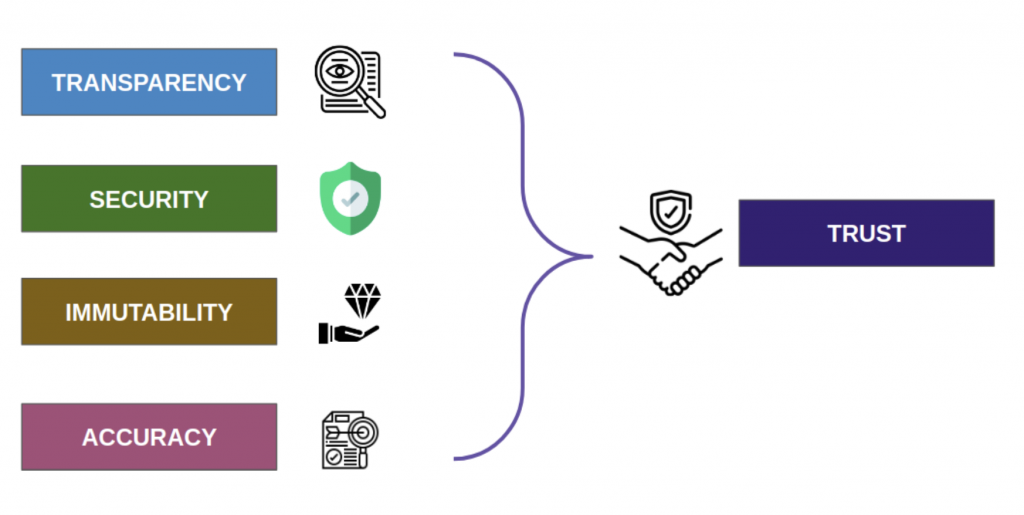
Federated Trust
In the following Knowledge Base, we explain the concept of trust and transparency to provide a clear understanding for developers and explorers of decentralised apps. Distributed social media’s evolution is an innovative solution that facilitates global outreach with improved trust and federated transparent control and ownership of the underlying environment.
In nearly every industry today, organisations face the challenge of finding efficient, secure methods to manage and share data related to transactions, contracts, assets, and more. From finance and real estate to healthcare and retail, information silos and disparate databases create operational inefficiencies and make true collaboration between business parties challenging to achieve. The governance of centralised social networks is in the hand of a single proprietary organisation controlling the platform, implementing surveillance capitalism. That leads to critical trust and governance issues over the content created and propagated within.
In contrast, a decentralised-based social network does not rely on central servers and thus, no single entity can enforce monitoring and control over user-generated content. It can also ensure the privacy of participants and security standards through a distributed consensus mechanism. A novel technology called blockchain allows companies to break down these data silos and digitally connect multiple systems, partners and customers. Blockchain is a permanent, connected, peer-to-peer ledger, which digitises transactions by saving each exchange in a series of cryptographic blocks. No single party can alter any records, and any change requires consensus from the majority of network participants. The resulting ledger is immutable, providing complete data transparency and building trust between all blockchain network members. Blockchain technology has given rise to a new platform for business relationships combining ease of use, low cost and high security. It creates a new basis of trust for business transactions that can make economic activities simpler, faster, and more efficient.
Organisations today face rapidly escalating complexity within almost all domains of activity. As our environments become more complex, bureaucratic organisations respond by creating more subsystems – specialised departments and domains – resulting in greater fragmentation into different silos. These silos provide the organisation with specialised capabilities for responding to its increased environmental complexity. The increasing complexity can be reduced by breaking things up. Since these developments are considered advantageous or critical for the companies, specialised information is not shared due to the fear of abuse by competitors or customers. The result is even greater resistance to the overall flow of information within the system and the overall opacity. Blockchain networks enable us to collaborate within a large community, connecting horizontally across different organisations and replacing proprietary technology with open-source protocols, greatly increasing transparency.

Trust is the foundation of every business-to-business (B2B) and business-to-customer (B2C) relationship. Success is built on it, and it is part of how we care for our business networks. Intermediaries serve as trusted third parties when mutual trust is not established in a mutually trusted relationship. Business organisations employ lawyers to ensure that their Intellectual Property Rights are not copied or illegally distributed. Overall, the use of intermediaries is very complex, costs a lot of time and money, and carries security risks. For example, intermediaries enlarge the security risks that malicious actors can exploit to gain access to confidential information or to launch a coordinated cyber attack. ARTICONF ensures trust and transparency among the federation of participating organisations by using a permissioned blockchain. Private permissioned blockchains like Hyperledger Fabric become more relevant for enterprises providing social DApps to enforce their governance model and policies. In contrast, public permissionless blockchains need organisations adhering to the existing governance model of the network.
The closed nature and misalignment of interests within today’s centralised organizations reduce transparency. For example, most social media companies do not explicitly tell that they make their profits from personal data through advertisements. The reason is that this represents a misalignment of interests; peoples’ need to connect and be social versus a platform whose revenue model is based on gathering their personal data). Likewise, their algorithms are black-boxed, opaque to users and a valuable commercial secret. Centralised systems create many boundaries that block information flow across the network and increase its overall opacity. When removing the centralised component in social media, we also remove the wall created around them, increasing transparency across whole networks. By switching to a peer-to-peer model, we switch to a model-based upon direct feedback between peers, without using intermediaries. To get that dynamic real-time information feedback loop, we need transparency: the information flows directly instead of being mediated. By realigning the interests of the network, we can make transparency possible. When the data is stored on the blockchain, everyone can audit what has happened in the tamper-proof reality of the truth acquired through consensus.
Malicious actors and fake news detection
Social networks have the potential to promote creativity using a transparent, value-centric, trustful, democratic and inclusive approach. DApp developers and providers can enhance and support collaborative participation across diversified geographical boundaries. ARTICONF delivers technologies to improve trust and eliminate malicious actors in participatory exchanges throughout the collaboration lifecycle. It researches heuristics (a problem-solving approach) coupled with blockchain to ensure verifiable and traceable content ownership while preserving anonymity. It provides abstractions to characterise diverse sets of participants and maintain their traceability and ownership activity down the network. Through these heuristics, ARTICONF will identify malicious actors and improve collaboration and trust in the environment without violating users’ privacy. Moreover, it will simplify and optimise maintenance costs and identify users with fake profiles to prevent malicious content. Enhancing trust through blockchain enables the vision of a new generation of social media, facilitating trusted social media discussions, informing better decisions, broader awareness, and access to information from different users perspectives. It can tackle fake news with multiple user perspectives, by requesting different people’s reviews about a relevant subject. The new heuristics improve trusted participation in use cases using a novel Pareto-trust metric that formally quantifies the quality of implicit and explicit trust-based collaboration considering various conflicting parameters, such as accuracy, timeliness and low latency ownership verification. Through this novel Pareto-trust metric, ARTICONF expects to enhance reliable content generation by 90% in event-oriented collaborative use case scenarios.
ARTICONF can help identify malicious actors in an anonymised context by innovating learning approaches to classify each actor using the SMART reputation model. At the same time, ARTICONF considers how an actors’ activity can be malicious in a particular context and not for others in its reputation model. The model provides an intelligent analytics interface about the activity of networked communities. This feature is available through the ARTICONF SMART tool, which provides services for semantic linking and decision making in a collaborative network of social objects.
ARTICONF addresses trust, time-criticality and democratisation for a next-generation of federated infrastructures to fulfil the privacy, robustness, and autonomy related promises that proprietary social ecosystems have failed to deliver so far. The project’s core goal is to create an interdisciplinary network to work collaboratively on the challenges related to improving trust, collective and individual transparency in the social networks. If you are planning to implement some of these methodologies, get in touch with us.
This Knowledge Base Resource was developed by University of Information Science and Technology “St. Paul the Apostle” – Ohrid and bitYoga teams. Our goal was to raise awareness related to the topics of transparency, trust and blockchain, malicious actors, fake news and disinformation.
< Thanks for reading. We are curious to hear from you. Get in touch with us and let us know what you think. >